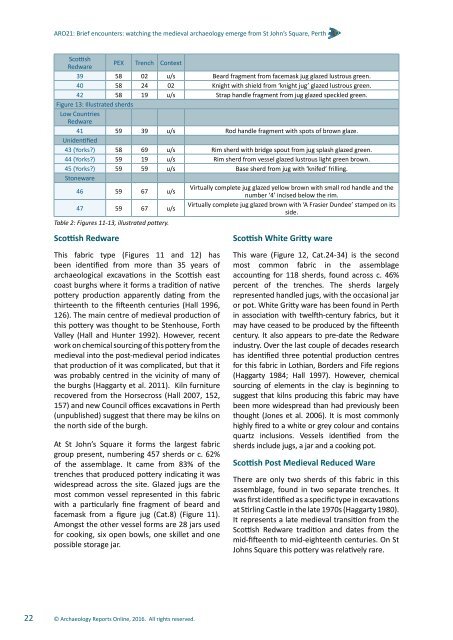medieval archaeology emerge from St John’s Square Perth
ARO21_St_Johns_Square
ARO21_St_Johns_Square
You also want an ePaper? Increase the reach of your titles
YUMPU automatically turns print PDFs into web optimized ePapers that Google loves.
ARO21: Brief encounters: watching the <strong>medieval</strong> <strong>archaeology</strong> <strong>emerge</strong> <strong>from</strong> <strong>St</strong> <strong>John’s</strong> <strong>Square</strong>, <strong>Perth</strong><br />
Scottish<br />
Redware<br />
PEX Trench Context<br />
39 58 02 u/s Beard fragment <strong>from</strong> facemask jug glazed lustrous green.<br />
40 58 24 02 Knight with shield <strong>from</strong> ‘knight jug’ glazed lustrous green.<br />
42 58 19 u/s <strong>St</strong>rap handle fragment <strong>from</strong> jug glazed speckled green.<br />
Figure 13: Illustrated sherds<br />
Low Countries<br />
Redware<br />
41 59 39 u/s Rod handle fragment with spots of brown glaze.<br />
Unidentified<br />
43 (Yorks?) 58 69 u/s Rim sherd with bridge spout <strong>from</strong> jug splash glazed green.<br />
44 (Yorks?) 59 19 u/s Rim sherd <strong>from</strong> vessel glazed lustrous light green brown.<br />
45 (Yorks?) 59 59 u/s Base sherd <strong>from</strong> jug with ‘knifed’ frilling.<br />
<strong>St</strong>oneware<br />
46 59 67 u/s<br />
Virtually complete jug glazed yellow brown with small rod handle and the<br />
number ‘4’ incised below the rim.<br />
47 59 67 u/s<br />
Virtually complete jug glazed brown with ‘A Frasier Dundee’ stamped on its<br />
side.<br />
Table 2: Figures 11-13, illustrated pottery.<br />
Scottish Redware<br />
Scottish White Gritty ware<br />
This fabric type (Figures 11 and 12) has<br />
been identified <strong>from</strong> more than 35 years of<br />
archaeological excavations in the Scottish east<br />
coast burghs where it forms a tradition of native<br />
pottery production apparently dating <strong>from</strong> the<br />
thirteenth to the fifteenth centuries (Hall 1996,<br />
126). The main centre of <strong>medieval</strong> production of<br />
this pottery was thought to be <strong>St</strong>enhouse, Forth<br />
Valley (Hall and Hunter 1992). However, recent<br />
work on chemical sourcing of this pottery <strong>from</strong> the<br />
<strong>medieval</strong> into the post-<strong>medieval</strong> period indicates<br />
that production of it was complicated, but that it<br />
was probably centred in the vicinity of many of<br />
the burghs (Haggarty et al. 2011). Kiln furniture<br />
recovered <strong>from</strong> the Horsecross (Hall 2007, 152,<br />
157) and new Council offices excavations in <strong>Perth</strong><br />
(unpublished) suggest that there may be kilns on<br />
the north side of the burgh.<br />
At <strong>St</strong> <strong>John’s</strong> <strong>Square</strong> it forms the largest fabric<br />
group present, numbering 457 sherds or c. 62%<br />
of the assemblage. It came <strong>from</strong> 83% of the<br />
trenches that produced pottery indicating it was<br />
widespread across the site. Glazed jugs are the<br />
most common vessel represented in this fabric<br />
with a particularly fine fragment of beard and<br />
facemask <strong>from</strong> a figure jug (Cat.8) (Figure 11).<br />
Amongst the other vessel forms are 28 jars used<br />
for cooking, six open bowls, one skillet and one<br />
possible storage jar.<br />
This ware (Figure 12, Cat.24-34) is the second<br />
most common fabric in the assemblage<br />
accounting for 118 sherds, found across c. 46%<br />
percent of the trenches. The sherds largely<br />
represented handled jugs, with the occasional jar<br />
or pot. White Gritty ware has been found in <strong>Perth</strong><br />
in association with twelfth-century fabrics, but it<br />
may have ceased to be produced by the fifteenth<br />
century. It also appears to pre-date the Redware<br />
industry. Over the last couple of decades research<br />
has identified three potential production centres<br />
for this fabric in Lothian, Borders and Fife regions<br />
(Haggarty 1984; Hall 1997). However, chemical<br />
sourcing of elements in the clay is beginning to<br />
suggest that kilns producing this fabric may have<br />
been more widespread than had previously been<br />
thought (Jones et al. 2006). It is most commonly<br />
highly fired to a white or grey colour and contains<br />
quartz inclusions. Vessels identified <strong>from</strong> the<br />
sherds include jugs, a jar and a cooking pot.<br />
Scottish Post Medieval Reduced Ware<br />
There are only two sherds of this fabric in this<br />
assemblage, found in two separate trenches. It<br />
was first identified as a specific type in excavations<br />
at <strong>St</strong>irling Castle in the late 1970s (Haggarty 1980).<br />
It represents a late <strong>medieval</strong> transition <strong>from</strong> the<br />
Scottish Redware tradition and dates <strong>from</strong> the<br />
mid-fifteenth to mid-eighteenth centuries. On <strong>St</strong><br />
Johns <strong>Square</strong> this pottery was relatively rare.<br />
22<br />
© Archaeology Reports Online, 2016. All rights reserved.


